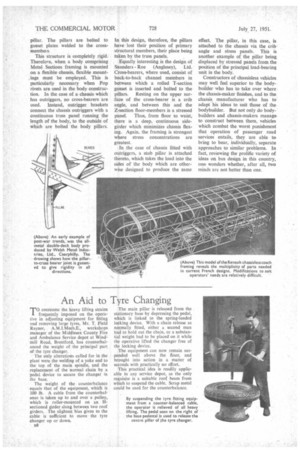An Aid to Tyre Changing
Page 42

If you've noticed an error in this article please click here to report it so we can fix it.
TO overcome the heavy lifting strains frequently imposed on the operative in adjusting equipment for fitting and removing large tyres, Mr. T. Field Rayner, A.M.I.Mech.E., workshops manager of the Middlesex County Fire and Ambulance Service depot at Windmill Road, Brentford, has counterbalanced the weight of the principal part of the tyre changer.
The only alterations called for in the plant were the welding of a yoke end to the top of the main spindle, and the replacement of the normal chain by a pedal device to secure the changer in the base.
The weight of the counterbalance equals that of the equipment, which is 100 lb, A cable from the counterbalance is taken up to and over a pulley, which is roller-mounted on an Hsectioned girder slung between two roof girders. The slightest bias given to the cable is sufficient to move the tyre changer up or down.
The main pillar is released from the stationary base by depressing the pedal, which is linked to the spring-loaded locking device. With a chain release as normally fitted, either a second man had to hold out the chain, or a substantial weight had to be placed on it while the operative lifted the changer free of the locking device.
The equipment can now remain suspended well above the floor, and brought into action in a matter of seconds with practically no effort.
This practical idea is readily applicable in any service depot, as the only requisite is a suitable roof beam from which to suspend the cable. Scrap metal could be used for the counterbalance.






























































































